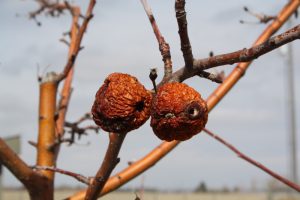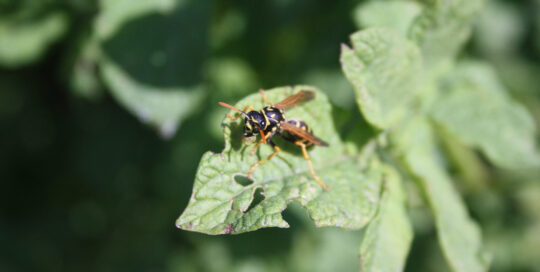Apple Mummies
Views: 5150

Forget zombies, I have apple mummies.
One of our apple trees did not thrive at all last year. It set fruit, but much of it stopped shortly after pollination, and the few apples left grew to a golf ball size before shriveling. They hung on throughout the winter, and now I need to deal with them, because these remains are perfect hosts for disease.
Apple Scab, Fire Blight, and Black Rot on Apples
Here in Montana the primary concerns are apple scab and fire blight. Apple scab is a fungus that is prevalent during cool, wet years, and is more common on the west side of the mountains. There will be spots on the fruit and leaves, and young fruit usually distorts and drops.
Fire blight is a greater concern. I dealt with it on the only mature tree we have several years ago. And while I received advice from a veteran orchardist to “prune with a shovel” (meaning to completely remove the tree), I cut off the infected branches and managed to save it. This involved a radical pruning of about a third of the tree, but it worked.
The other symptoms of fire blight include cankers, blackened twigs and leaves, and it’s not unusual for the leaves to hang on throughout the winter. Although this tree doesn’t have all of the symptoms, I’m leaning towards the fire blight possibility.
In other parts of the country, there are other fungal issues that cause the apple mummies hanging on the tree. Black rot is one of the more prevalent, particularly in the East and Midwest. It’s a fungal infection, often attacking following an initial infection of some sort. A common combination is a tree exhibiting signs of frogeye leaf spot, including purplish lesions with brown centers on the leaves, followed by the black spot fungus.
Besides the apple mummies, there are often cankers on the tree. When it warms up in the spring, the spores found in these cankers, as well as the mummified fruit are easily spread to healthy trees.
Prevent Apple Mummies
If you are dealing with mummies you need to be cautious and thorough in your spring cleanup. Even if you can’t pinpoint the source of infection, treat it as a hazard to the rest of your trees.
Bag up all of the apples (on the tree and any that are still on the ground), and toss it in the garbage. Do not compost it. When you prune your tree, disinfect the tool you use after every cut. Yes, it’s tedious, but it’ll potentially save yourself a whole lot of work later. Bag any of the trimmings and throw them away, as well.
If you know it’s a fungal infection, you can spray your tree according to the label instructions on the appropriate fungicide. The timing of the applications depends on what type of infection you’re tackling, as well as the climatic conditions. In this case, your best bet is to talk to your local Extension agent to gain an idea of when you need to apply the fungicide. (If you have mummified fruit now, call them immediately. It won’t be long before buds break in many parts of the country.)
Starting off the season with a potential fungal or bacterial problem is no fun. But if you handle the issue correctly from the start by practicing good hygiene and treating the tree (if necessary) you can save the tree and improve production.
Meet Amy Grisak
Amy is a freelance author and photographer in Great Falls, MT who specializes in gardening, foods, and sustainable agriculture. She provides information on every kind…
Amy's Recent Posts

Looking into the Crystal Ball for a Pest Report








